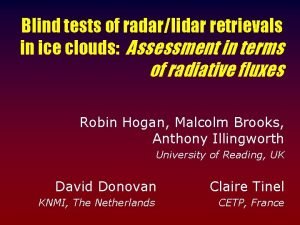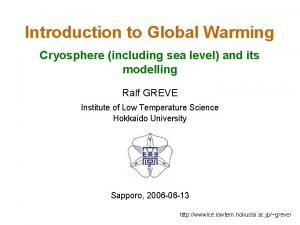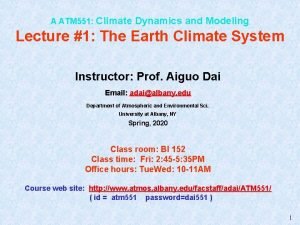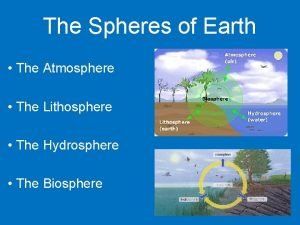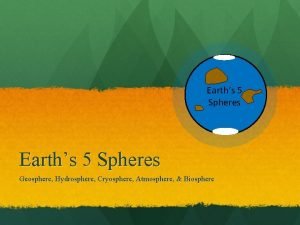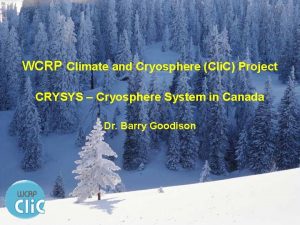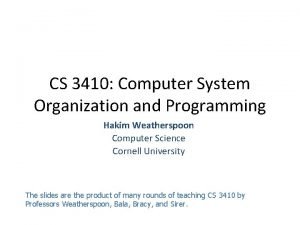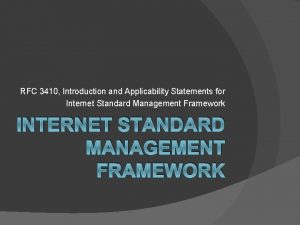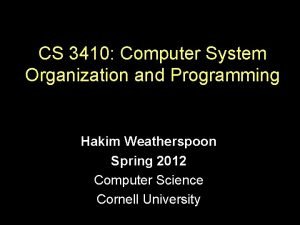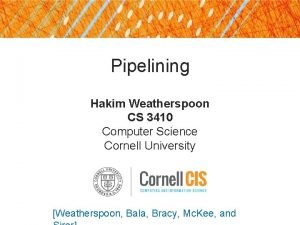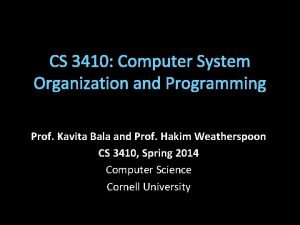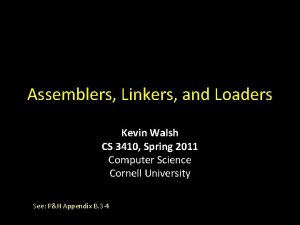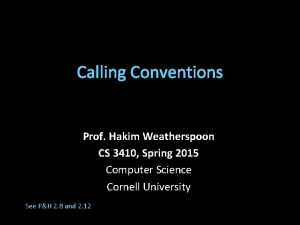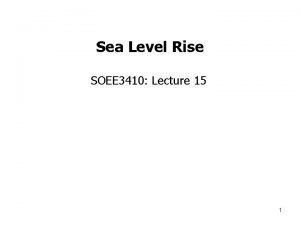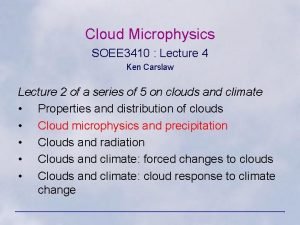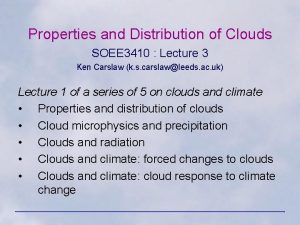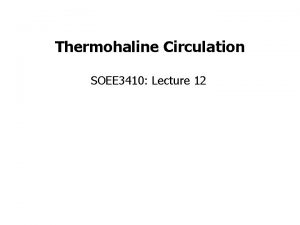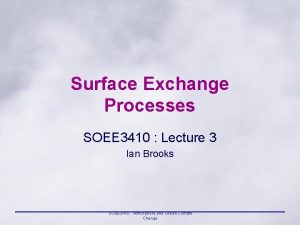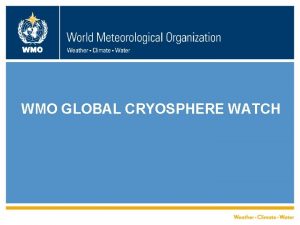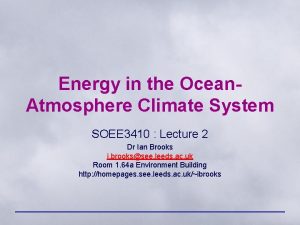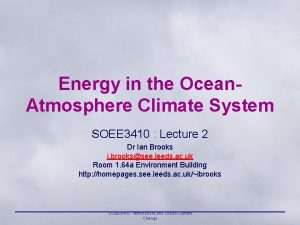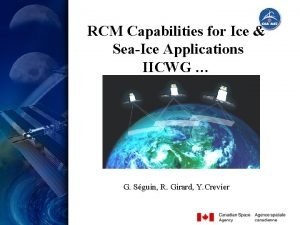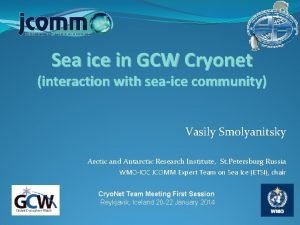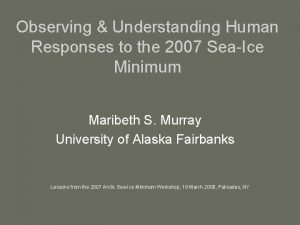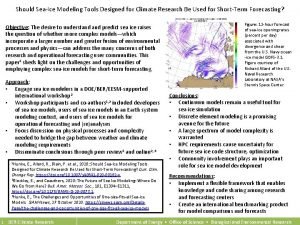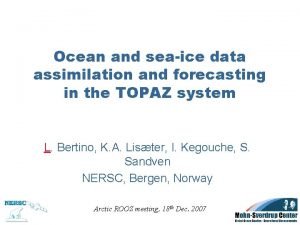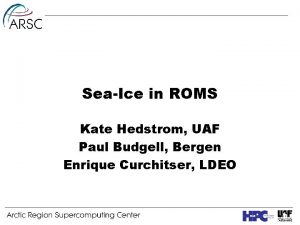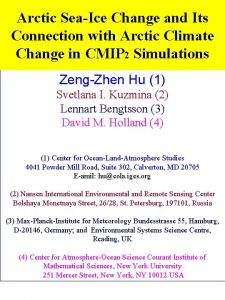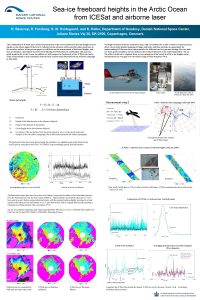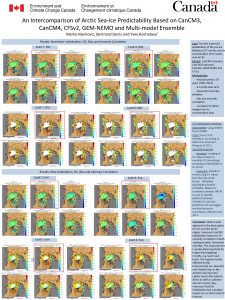Seaice the cryosphere SOEE 3410 Lecture 14 Seaice






















- Slides: 22

Sea-ice & the cryosphere SOEE 3410: Lecture 14

Sea-ice & the cryosphere • Ice-production • Formation of “polynyas” • Heat exchanges • Feedback systems • Extent and seasonality of sea-ice • Climate implications SOEE 3410 : Coupled Ocean & Atmosphere Climate Dynamics

N Atlantic: Brine expulsion & deep convection The temperature, salinity ranges of NADW: 0 -2 C and 34. 88 - 34. 93 PSU in the west 1. 8 - 3 C and 34. 98 - 35. 03 PSU in the east. SOEE 3410 : Coupled Ocean & Atmosphere Climate Dynamics

Antarctic Bottom Water (AABW) - Weddell Sea (deep convection site) SOEE 3410 : Coupled Ocean & Atmosphere Climate Dynamics

Antarctic Bottom Water T: -0. 25 to -1. 4 C S: 34. 63 – 34. 65 PSU. • Cold air near Antarctica cools the ocean to the point that sea ice begins to form • Ice forms, salt is released to the water beneath the new ice. • Both the low temperatures and higher salinity make the surface water sufficiently dense enough to sink 4 km to the bottom of the ocean SOEE 3410 : Coupled Ocean & Atmosphere Climate Dynamics

Polynyas Extensive open-water (ice-free) areas bordered by winter ice cover, generally in well-defined areas Size: 100 m - 1000 km Two mechanisms can contribute to keeping polynyas open: 1. Latent (or coastal) polynyas: 2. Sea ice grows in open-water and is continually removed by winds and currents (often off shoreline) - latent heat released to the ocean during ice formation perpetuates the process – described as “sea-ice factories” – balances loss to atmosphere. 2. Sensible heat (or open-ocean) polynyas: Upwelling warm waters, vertical heat diffusion, or convection may provide enough oceanic heat flux to maintain ice-free region Reading: “Polynyas and leads: …”, Smith et al. , 1990, JGR, Vol. 95, 9461 -9479 Examples of major Polynya in the Antarctic: Ronne Ice Shelf Polynya, Ross Sea Polynya, Terra Nova, Bay Polynya SOEE 3410 : Coupled Ocean & Atmosphere Climate Dynamics

Weddell Sea Polynya (NASA) SOEE 3410 : Coupled Ocean & Atmosphere Climate Dynamics

Weddell Sea Polynya Low ice concentration close to coast – coastal Polynya SOEE 3410 : Coupled Ocean & Atmosphere Climate Dynamics

Two mechanisms for sustaining polynyas: Sensible Heat Latent Heat loss Qnet ~ -200 Wm-2 Qnet ~ -300 Wm-2 Brine Formation Offshore wind Water -1. 9 C Convection Cells Cold Saline Waters Cold Dense water 2000 - 4000 m AABW Antarctic Continental Shelf

Heat exchange: ocean - sea-ice - atmosphere • Ice acts as blanket over the ocean i. e. sea ice prevents the ocean heating lower atmosphere • Ice and the sustained snow cover prevent the turbulent exchange of heat and momentum at the ocean/atmosphere interface • A cooler atmosphere is supported by high albedo (reflectivity of sea ice) • Ice (high albedo) reduces absorption of short-wave radiation • Qlw is similar for both ice and water • Sea ice is highly dynamic i. e. constantly susceptible to the effects of the wind, precipitation, ocean tides SOEE 3410 : Coupled Ocean & Atmosphere Climate Dynamics

Feedbacks: ocean - sea-ice - atmosphere Albedo-Temperature An atmospheric warming (cooling) implies: • A decrease (increase) in the sea-ice area • Smaller (larger) regional surface albedo Sea ice modification of evaporation rates A decrease in the sea-ice compactness through melting: • Higher water-vapour concentration in the lower atmosphere • Stimulates the absorption of long wave radiation – warming air • Further ice ablation An increase in the sea-ice compactness through freezing: • Lower water-vapour concentration in the lower atmosphere • Inhibition of long wave radiation absorption • Supporting further ice accretion SOEE 3410 : Coupled Ocean & Atmosphere Climate Dynamics

Feedbacks: clouds (over Arctic Seas) Schweiger, A. J. (2004) Changes in seasonal cloud cover the Arctic seas from satellite and surface observations, Geophysical Research Letters, Vol. 31, L 2207, doi: 10. 1029/2004 GL 020067, 2004. SOEE 3410 : Coupled Ocean & Atmosphere Climate Dynamics

Feedbacks: increasing GHGs on temperature Winter mean temperature change for doubling CO 2 From IPCC Assessment, Houghton, et al. , 1990 SOEE 3410 : Coupled Ocean & Atmosphere Climate Dynamics

Polar surface temperature trends: 1981 -2000 • North pole: - +ve T trend on Canadian side - -ve T rend on Russian side • South pole: - +ve T trend over sea-ice cover - -ve T trend over parts of continent From Sea Ice, Thomas and Dieckmann, 2003 SOEE 3410 : Coupled Ocean & Atmosphere Climate Dynamics

Extent & seasonal variation of ice • North pole: - semi-enclosed basin => relatively little seasonal variation • South pole: - ice cover shifts ~20 o latitude - almost all sea ice melts in summer SOEE 3410 : Coupled Ocean & Atmosphere Climate Dynamics

Annual and seasonal sea-ice extent in N hemisphere: 1901 -1999 (Annual values from Vinnikov et al. , 1999 b; seasonal values updated from Chapman and Walsh, 1993). SOEE 3410 : Coupled Ocean & Atmosphere Climate Dynamics

Sea-ice thickness – from submarine measurements From Rothrock et al. , 1999 http: //nsidc. org SOEE 3410 : Coupled Ocean & Atmosphere Climate Dynamics


Arctic Oceans: freshwater input – air temperature (1936 -1999) Peterson et al. , Science Vol. 298, 2002 1 Sv = 106 m 3 s-1 Hydrologic sensitivity is the main control variable that determines the future response of the THC! SOEE 3410 : Coupled Ocean & Atmosphere Climate Dynamics

Labrador Sea: freshening at all depths Salinities through water column: 1950 -2001 • Rapid & long-term freshening SOEE 3410 : Coupled Ocean & Atmosphere Climate Dynamics

Climate implications: thermohaline circulation collapse Model outputs: change in annual temp, 30 years after collapse of thermohaline circulation Figure courtesy of Michael Vellinga, Hadley Centre. SOEE 3410 : Coupled Ocean & Atmosphere Climate Dynamics

Summary: sea-ice • Formation of sea-ice at poles • Changes in heat exchanges due to sea-ice • Production of polynyas – importance in heat exchange • Feedback loops associated with sea-ice • Geographical / seasonal / climatological variations in sea-ice • Evidence of freshening of Nordic Oceans • Implications for thermohaline circulation SOEE 3410 : Coupled Ocean & Atmosphere Climate Dynamics
 Soee test
Soee test Graf soee
Graf soee Cryosphere
Cryosphere Cryosphere
Cryosphere The hydrosphere and lithosphere meet
The hydrosphere and lithosphere meet Earth's 5 spheres
Earth's 5 spheres Wcrp climate
Wcrp climate 01:640:244 lecture notes - lecture 15: plat, idah, farad
01:640:244 lecture notes - lecture 15: plat, idah, farad Cs 3410
Cs 3410 Rfc 3410
Rfc 3410 Cs 3410 cornell
Cs 3410 cornell Cornell cs 3410
Cornell cs 3410 Cs 3410
Cs 3410 Cs 3410
Cs 3410 Cs 3410
Cs 3410 Cs 3410
Cs 3410 Môn thể thao bắt đầu bằng từ đua
Môn thể thao bắt đầu bằng từ đua Hát kết hợp bộ gõ cơ thể
Hát kết hợp bộ gõ cơ thể Khi nào hổ mẹ dạy hổ con săn mồi
Khi nào hổ mẹ dạy hổ con săn mồi Các loại đột biến cấu trúc nhiễm sắc thể
Các loại đột biến cấu trúc nhiễm sắc thể điện thế nghỉ
điện thế nghỉ Biện pháp chống mỏi cơ
Biện pháp chống mỏi cơ Trời xanh đây là của chúng ta thể thơ
Trời xanh đây là của chúng ta thể thơ
